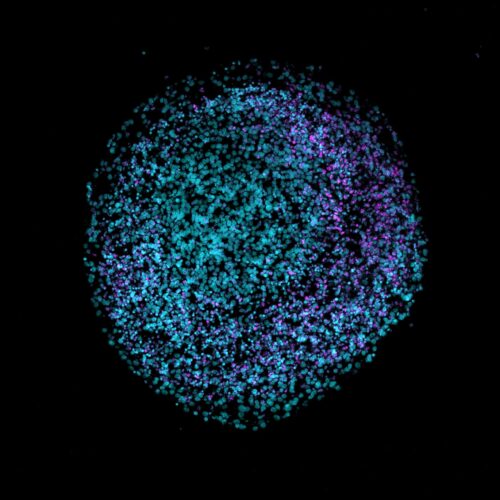FMRP Regulatory Role in Human Hippocampal Development and Therapeutic Interventions in Fragile X Syndrome

Zhexing Wen, PhD
Principal Investigator
Jie Xu, PhD
FRAXA Postdoctoral Fellow
Peng Jin, PhD
Mentor
Emory University School of Medicine
Atlanta, GA
2025-2026 Grant Funding: $100,000
Summary
This project focuses on how Fragile X affects the hippocampus — a part of the brain critical for learning, memory, and emotional regulation. Using lab-grown hippocampal organoids from pluripotent stem cells, the team has found that people with FXS produce too many neurons and too few support cells, which may overload brain circuits.
They will now study which genes are disrupted when FMRP is missing and how this affects brain cell communication. They’ll also test whether PDE inhibitors can restore the proper balance of cell types. PDE inhibitors (such as Zatolmilast) are in clinical trials for Fragile X.
The Science
by Drs. Jin, Wen, and Xu
Fragile X syndrome (FXS) results from the full mutation of the FMR1 gene that causes a complete loss of its protein product, Fragile X messenger ribonucleoprotein (FMRP). FMRP is a multifunctional RNA-binding protein that binds to selective mRNAs and regulates their stability, editing, transport, and translation. Its absence disrupts neurodevelopment, resulting in cognitive and behavioral impairments in individuals with Fragile X.
The hippocampus, a brain region critical for learning, memory, and emotional regulation, is a major site of FMR1 expression and hence highly vulnerable to FMRP loss. Despite evidence of hippocampal enlargement in younger affected individuals, the regulatory role of FMRP and the molecular and cellular impacts of its loss on human hippocampal development remain poorly understood.
To address these gaps, we have developed hippocampal organoids from induced pluripotent stem cells (iPSCs) of FXS-affected individuals and healthy controls.
Our preliminary findings reveal increased production of neurons and decreased decreased production of glial cells in FXS hippocampal organoids. This may contribute to the neural network hyperexcitability observed in these models. However, the molecular mechanisms driving these phenotypic alterations and the effects of imbalanced neurogenesis and gliogenesis on network communication remain to be understood.
This project aims to address these questions through two key objectives:
- To identify the specific mRNAs regulated by FMRP during hippocampal development and the gene regulatory networks disrupted in FXS. This will enable us to establish molecular signatures of FXS and predict potential therapeutic compounds.
- To explore how FMRP loss affects network communication in hippocampal organoids, focusing on neuron-astrocyte crosstalk, and identify druggable ligand/receptor pairs with strong potential to restore normal network functioning.
- We will also test the therapeutic effects of phosphodiesterase (PDE) inhibitors, which have shown promise in improving synaptic function and rescuing neural network deficits in FXS hippocampal organoids.
By uncovering the molecular mechanisms driving FXS-associated alterations and testing potential treatments in human hippocampal organoids, this project will provide valuable insights into FMRP’s regulatory role during hippocampal development, identify potential therapeutic targets, and lay the groundwork for drug repurposing in Fragile X syndrome.

